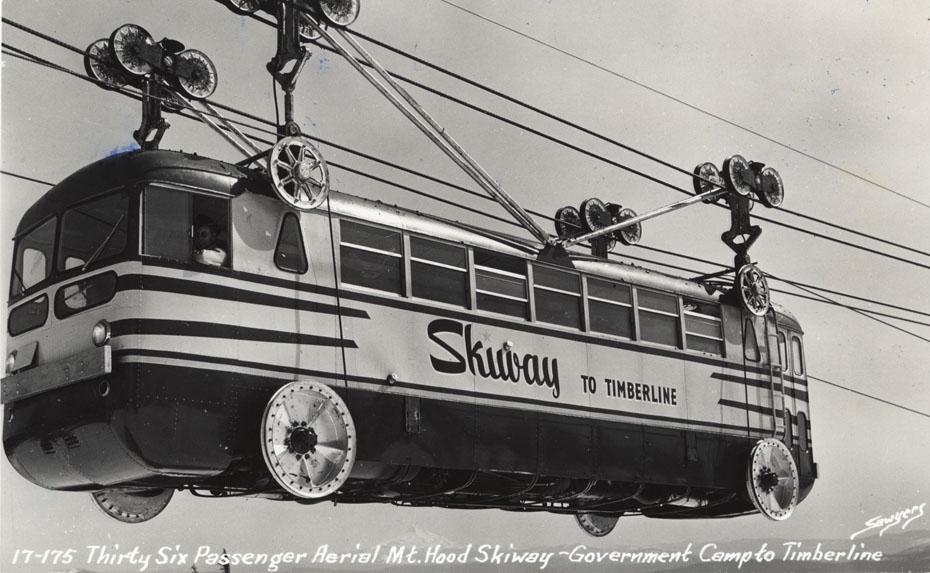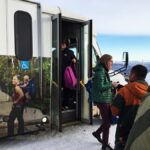Is there anything worse than coming off a fabulous day of skiing on Mt. Hood only to be stuck in soul crushing traffic along with thousands of other drivers heading home to Portland?
Not much. But alas: it’s easy to imagine a time when it will be faster to ski than drive down the mountain. US 26 and OR 35 are already overcrowded, and traffic is only going to get worse as thousands of people move to Portland and Hood River in the coming years.
“Transportation and parking is a key issue in the future success of Mt. Hood’s ski areas, the village of Government Camp, and recreational areas,” says Jon Tullis, director of public affairs for Timberline Lodge. “We need to get ahead of it and plan to accommodate it.”
Local, regional and national stakeholders are doing just that.
Last year, the Oregon Department of Transportation, in partnership with Mt. Hood National Forest, Clackamas County, Hood River County and FHWA-Western Federal Lands Highway Division, completed the Mt. Hood Multimodal Transportation Plan, a roadmap aimed at relieving congestion and improving highway safety.
The MHMTP features a set of recommended programs and projects, along with an implementation/action and funding strategy.
“There’s a lot of work to be done,” says Mike Mason, an ODOT project manager. “But the plan has given a lot of momentum to get things moving.”
Exhibit A is the Mt. Hood Transit Alliance, a public-private partnership that in 2013 launched the Mt. Hood Express bus service from Sandy to Timberline.
The Express has been a huge success. December 2014 ridership hit a record with 5,687 trips, according to coordinator Jacques Livingston.
As Tullis notes, the bus does more than serve recreational riders; it also provides affordable transportation for the Mt. Hood workforce. (Cost is $2 one way; $5 for an all day pass). The service is adding a third bus and the alliance is seeking a sustainable revenue stream for the grant funded program. Another MHMTP project aims to expand the bus connection to Hood River.
Also on the list is a park and ride shuttle lot, to be sited on federal land near Government Camp. The Mt. Hood Express, ski areas and private transportation carriers would provide the shuttle service to the ski areas and other attractions.
The 38 projects in the plan are prioritized according to feasibility, level of support and funding potential. The plan also contains some grand ideas, namely, a gondola serving Government Camp, Timberline and Mt. Hood Ski Bowl.
As fanciful as it seems, a Mt. Hood gondola is not a new idea. In the 1950s, an aerial tram of sorts, the Mt. Hood Skiway, ferried passengers from Government Camp to Timberline.
Working models abound: think Whistler or Telluride, in which sleek aerial trams whisk riders from ski villages to mountains without any need for car transportation.
It’s ski season, so all eyes are on snow sports. But Mt. Hood is a year round destination — and interest in fair weather activities will likely grow as climate change continues to erode the winter snow pack.
The transportation plan includes projects aimed at year round recreation: e.g., improving bike access and parking congestion at overcrowded hiking/snowshoe trails like Mirror Lake. Several traffic management and safety projects, including a $5 million Intelligent Transportation Systems project on Highway 26, are also underway.
The big picture
Mt. Hood is a majestic natural resource, but the transportation and planning infrastructure are woefully inadequate. Tullis offers a compelling vision in which Mt. Hood, especially the area around Government Camp, evolves from a car centric highway town into a walkable village, fueling recreation, tourism and job creation.
“We want to offer a pedestrian-oriented experience,” Tullis says. “You need a sense of arrival: the sense that ‘I am here.'”
It’s ironic. Oregon is known as a transportation leader, but so far the innovations have focused on urban transit options: light rail, bike infrastructure and now ridesharing. All those car-free denizens in Portland have little choice but to jump in an automobile to get to the mountains.
Whether public and private champions will succeed in reorienting development remains to be seen. A quick scan of the MHTMP reveals a glaring gap in the big ideas category: no proposals for a ski train linking metropolitan Portland to the mountain. Nevertheless, the Mt. Hood Multimodal Transportation Plan sets the stage for a new approach — and offers a glimpse of an après-ski future that doesn’t include those soul crushing traffic jams.
***
Check out this video of the ingenious Mt. Hood Skiway. Not sure I’d feel safe in a Downtown Trailways bus hanging from wire ropes. “But it worked,” says Tullis. “And it’s not so different from the criteria that makes everyone believe it will work today.”




